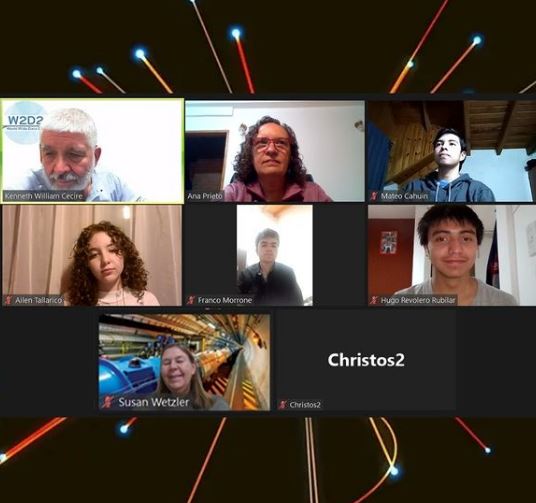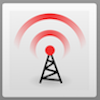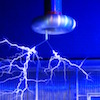Friday Flyer - November 10, 2023

Spotlight on World Wide Data Day
What happens when you get 43 physics classrooms from 12 countries together online with 16 scientist moderators from 7 countries to discuss a simple but profound set of measurements from ATLAS and CMS all in one day? You get World Wide Data Day (W2D2), the 2023 edition of which concluded yesterday.
Students measured the directions of tracks in dimuon events from ATLAS and CMS using online event displays and protractors under the tutelage of their teachers. Teachers compiled results and put them in the Worldwide Google Sheet so that, in the videoconferences, the combined results were ready to display and discuss. There are two angle measurements for each muon track: θ and φ. The measures of these go into a histogram to see how many tracks are in each angle bin. Doing this, students effectively mapped out the response of each detector in three dimensions.
In the videoconferences, which ran all day UTC, students could discuss these results with moderators and ask just about any questions they wanted to, and they had some great questions!
W2D2 is over for 2023 but it will be back in or near November 2024. Join us then! In the meantime, feel free to try the measurement in your class anytime. And if you want a little help, Ken and Shane are at the ready.


News from QuarkNet Central
Registration for International Masterclasses (IMC) 2024 opened early this morning! It is time to get the jump on scheduling your masterclass. This year, all Fermilab-based masterclass videoconferences - ATLAS, CMS, MINERvA, and NOvA - have a single registration form. Fermilab videoconferences run March 1-27 in 2024, while CERN-based videoconferences start earlier but end on the same date. Want to learn more? Of course you do! Take a look at the IMC 2024 Circular that came out today.
International Cosmic Day is on November 21. If you have a detector, do an experiment to submit! If not, use ICD-provided online data or data from the QuarkNet Cosmic Ray e-Lab.
AAPT Winter Meeting 2024 will take place in New Orleans on January 6-9. Several QuarkNet members will be at this conference presenting in sessions like 21st Century Physics in the Classroom and Cosmic Ray Studies in the Classroom. Join us if you can!
Mostly for mentors and/or lead teachers: If you have not done so already, please submit your Annual Reports and invoices for the fiscal year that just ended on August 31. Sooner is better! Not sure what to do? Check out these instructions or ask the staff!
Reminder: periodically check the QuarkNet Calendar for what's coming up in QuarkNet. When logged in, go to COMMUNITY > EVENTS to find this calendar. As we improve the calendar, you will see more information about, not only coming events, but applications, due dates, etc.

Physics Experiment Roundup
DUNE has a pretty famous prototype at CERN of its far detector, aptly named ProtoDUNE. Well, a long baseline experiment needs a near detector, too, and Fermilab News tells us about 2x2, the prototype for ND-LAr. Moving over to the LHC, APS Physics informs us of a new observation in ATLAS: a single top quark with a photon, plus, from the nuclear physics world, of the very rare isotope nitogen-9, which decays by emitting five protons.
Continuing with APS Physics, but moving more toward astrophysics news, we learn that the European Pulsar Timing Array (EPTA) has used Milky Way pulsar data to rule out some possible forms of dark matter and find out about how to quiet noise in gravitational wave detectors.

Resources
Today we have a sort of symposium on advance computing, including the quantum kind. We start in Symmetry, which asks if we can make a computer to simulate the universe. Fermilab News starts to answer with an article on how the Fermilab Superconducting Quantum Materials and Systems (SQMS) Center is starting its Quantum Garage to advance quantum information science and technology. CERN Bulletin jumps in, discussing virtual copies of reality and their impact. Back to Fermilab, maybe we can get some insight with this video on their Information Technology Division and a recent Don Lincoln offering, Demystifying the Heisenberg Uncertainty Principle. What does the Uncertainty Principle have to do with Quantum Computing? We get one answer from Blue Qubit and another from Linked In. And QuantaVerse has a video to answer the question as old as Noah, what's a qubit?

Just for Fun
Let's think seriously about fun. We all know that humor helps us to communicate (and to laugh), so it should not be a surprise that this is true in science as well. APS Physics explains with Comedy as a Tool to Demystify Science. They know this at XKCD: here is an example. And another example. And this one has nothing to do with science. (See how we tried to use the comedy rule of three to Improve Conversation?)
On the other hand, Interactions proposes to demystify science using, well, mystery. It might just work.
But what about fun? Try this crossword. Answers will be in the next Friday Flyer.
QuarkNet Staff
Mark Adams: adams@fnal.gov
Ken Cecire: kcecire@nd.edu
Spencer Pasero: spasero@fnal.gov
Shane Wood: swood5@nd.edu
